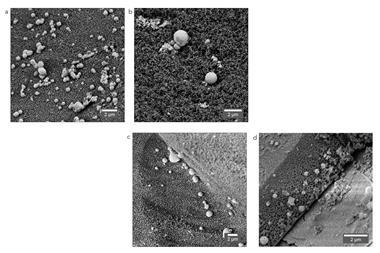Nanoparticles can be used to produce small amounts of hydrogen peroxide with less precious metals in straightforward process
A new cheaper, more effective catalyst for producing hydrogen peroxide directly from hydrogen and oxygen has been created.1 Researchers in the UK and US say that the method should make production of dilute hydrogen peroxide for water purification, disinfection and other applications more practical.
Hydrogen peroxide is currently produced industrially by hydrogenating the aromatic organic compound 2-alkyl-anthraquinone to the corresponding anthrahydroquinone with hydrogen. Dehydrogenation with oxygen then produces concentrated hydrogen peroxide. The process is uneconomical for making small amounts of hydrogen peroxide however, so concentrated amounts of the chemical have to be transported from a central plant before being diluted for use. This, says Graham Hutchings of Cardiff University, is ‘not safe by any means’.
A process better suited to small-scale production involves the palladium-catalysed reaction of hydrogen and oxygen in solution. Unfortunately, palladium catalyses not only the hydrogenation of oxygen to hydrogen peroxide, but also hydrogen peroxide’s further hydrogenation to water. In 2009, Hutchings and colleagues showed that a catalyst containing gold and palladium nanoparticles could produce hydrogen peroxide, but didn’t lead to its decomposition.2 Unfortunately, gold and palladium are too expensive to make this approach economical.
In the new research, Hutchings’ group unveil a new catalyst impregnated with palladium and tin. They oxidised the metals by heating them in air, after which they studied the surface using multiple analytical techniques. Palladium was present in both larger nanoparticles containing a mixture of palladium and tin and smaller nanoparticles containing mostly palladium embedded within tin oxide. Suspecting that only the smaller nanoparticles catalysed the decomposition reaction, the researchers reduced and re-oxidised the catalyst, causing the tin oxide to encapsulate the smaller palladium nanoparticles. The resulting catalyst was very active for the synthesis of hydrogen peroxide, without any decomposition problems. ‘We’ve taken the palladium content down from 2.5% to 0.5% in some formulations and taken the gold out altogether [compared with the 2009 catalyst],’ says Hutchings.

‘Tin is currently used as promoter for platinum-based light alkane dehydrogenation catalysts,’ say Bert Weckhuysen of Utrecht University in the Netherlands. ‘Hutchings’ group here is using this tin to fine tune the catalytic properties of supported palladium nanoparticles to make sure that unwanted side- reactions are switched off. I think this an important finding for an important reaction.’ He believes more information is needed, however, about the stability of the catalyst material.
Gabriele Centi of the University of Messina also wants more data on catalyst stability, and foresees a potential obstacle to the process, which uses methanol as a solvent. ‘If you use hydrogen peroxide for wastewater treatment or soil cleaning, for example, you need to get rid of the alcohol and have water as the solvent.’
References
1 S J Freakley et al, Science, 2016, DOI: 10.1126/science.aad5705
2 J K Edwards et al, Science, 2009, 323, 1037 (DOI: 10.1126/science.116898)












No comments yet